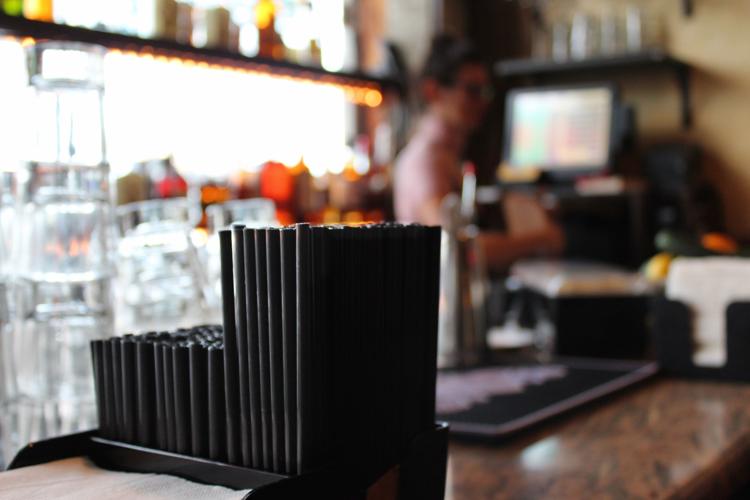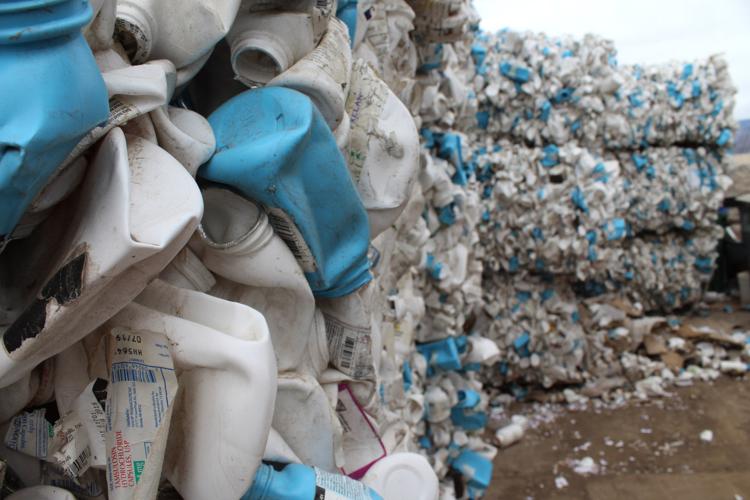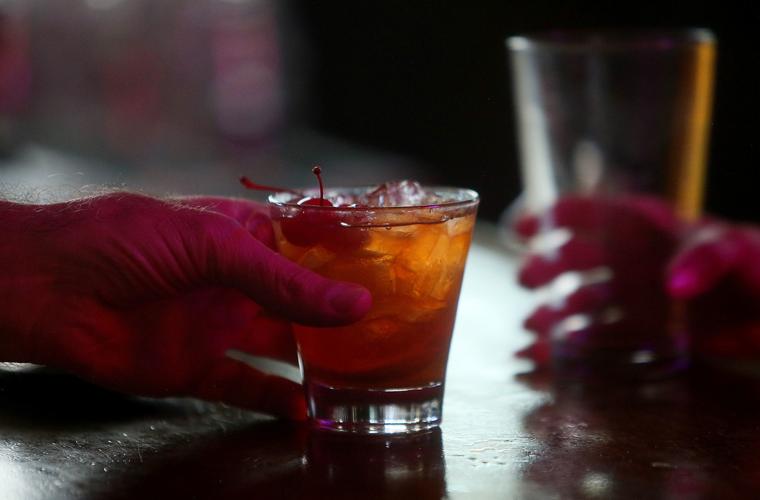A plastic straw is typically used for only about 20 minutes; then it lives for some 200 years, leaching chemicals into a landfill and polluting waterways and oceans.
The plastic straw is at the heart of the growing environmental campaign to reduce plastic consumption in hopes of saving the oceans from chemical and physical effects of single-use plastics on marine and human life.
In Tucson, restaurants like Hotel Congress and Maynards Market are giving plastic straws to customers only on request. They are part of the national #stopsucking campaign among restaurants.
“We had been making other green initiatives, so the straws seemed like low-hanging fruit and easy to eliminate, especially after understanding how many straws are used and how plastic impacts the environment,” said Rita Dorsey, the director of training and development at Hotel Congress.
Some 8 million metric tons of plastic — the equivalent of 22,000 747-jumbo jets or 1 million elephants, by weight — enter the oceans annually, and since plastic is not biodegradable, it lingers in water, enters the food chain and hurts fish, animal and human development.
Straws are a perfect place to make a stand against plastic, said Gina Murphy-Darling, a Tucson-based environmental educator who podcasts nationally as Mrs. Green.
“They hold a neutral position because they are given and not purchased,” she said. “By people asking themselves if they need a straw or not, they can live more consciously and be a part of the solution for the environment.”
Tucson’s city center is about 215 miles to the nearest ocean, the Sea of Cortez, but our plastic consumption still affects oceans and waterways like the Central Arizona Project.

Plastics from many items, including straws, end up in the oceans and degrade, and are eventually eaten by fish.
Plastic islands
Americans use an average of 1.6 straws a day, with 500 million entering the ecosystem.
The Ocean Conservancy, a Washington D.C.-based nonprofit, sponsors an annual coastal cleanup that used half a million volunteers in 112 countries last year. In its 2017 International Coastal Cleanup Report, the conservancy reported that straws were the seventh-most-common item found. The volunteers collected 409,087 straws and stirrers. Straws and stirrers are ranked sixth in the United States. Cigarette butts were most common, followed by plastic bottles.
An estimated 80 percent of marine debris originates as land-based trash, according to the U.S. Environmental Protection Agency. Most are single-use plastics.
Straws and other debris become lost at sea, endlessly afloat, catching a ride on the currents and collecting in the ocean as large “plastic islands,” according to Katrina Mangin, a marine science instructor at the University of Arizona. “Fish and other animals are attracted to the shelter the islands provide due to the exposure of the vast ocean.”
One of the most infamous of these islands is the Great Pacific Garbage Patch. This giant floating web of trash holds 180 times more plastic than marine life, according to The Ocean Cleanup, which also reports that the polluted plastic “could be a primary food source in this region.”
Mangin described images of decomposed sea birds — their intestines sculpted by trash and plastic — amongst the Papahanaumokuakea Marine National Monument, the largest national marine-protected area on Earth. Encompassing the uninhabited northwestern islands of Hawaii, the monument provides sanctuary for endangered species such as the short-tailed albatross.
Former President Barack Obama quadrupled the size of the reserve in August 2016. The 582,578-square-mile area is now larger than all national parks combined. Yet, remnants of human consumption are still visible on the remote beaches and in the bodies of sea animals.
The first comprehensive impact assessment of trash on marine wildlife was published in January 2016 in the Marine Policy by Ocean Conservancy and the Commonwealth Scientific and Industrial Research Organization (CSIRO). The assessment provided clear evidence of the impact of debris on marine wildlife, including entanglement, ingestions and contamination, and suggested that “a comprehensive approach to preventing plastics from entering the ocean is vitally needed” to turn the tides.
Micro-plastics are tiny particles of plastics that are less than 5 millimeters in length and leak persistent, bioaccumulative and toxic chemicals into the waters, which can alter reproductive success and development of fish and invertebrates.
“Micro-plastics break down into tinier and tinier particles, which are then eaten by plankton, and plankton get eaten by the fish,” Mangin said. “So the plastics chemicals are entering the food chain, very directly. We eat plastic when we eat seafood.”
Bottled water, in addition to being a major contributor of plastic pollution, paradoxically contains more plastic than tap water, according to recent research by the State University of New York at Fredonia that tested more than 250 bottles from 11 different brands across nine countries. Each liter averaged about 10 plastic particles, or twice that found in tap water.
Fifty-four percent of the plastic found in bottled water was polypropylene, whose versatility makes it a common component of packaging and plastic products like bottle caps and straws. Polypropylene helps stabilize straws and allows them to be flexible, light weight and durable.

Blocks of single-use plastic prescription bottles from the local VA sit by the dozens on Tank’s Recycling and Landfill Center in Tucson, Arizona on Saturday, March 10, 2018.
Tough to recycle
In place of plastic, straws can be made from naturally degradable products like paper or bamboo, or reusable materials like metal or glass. None are as cheap as plastic.
“It is not always feasible to make a material both adequate for the required task and biodegradable and affordable,” said James Baygents, associate dean in the UA College of Engineering.
The EPA predicts that “much of the plastics made still exist, whether it be in their original, decomposed or chemical states.”
Polypropylene is derived from oil; therefore, the price of plastic is directly linked to the oil market. The plastic market represents 6 percent of global oil consumption, equal to the total consumption of the global aviation sector.
“Straws make me cringe,” Murphy-Darling said. “I tend to be a drama queen anyway, but it makes me cringe because I think: ‘Do you have idea what that took to make?’ They are one of the most energy-intensive single-use products created.”
Murphy-Darling said the straw manufacturing chain is wasteful. It begins with the drilling and shipment of oil, then energy is used for manufacturing and packaging, and then straws are shipped across the country or the world.
The process to make new plastic is often cheaper than using recycled products. Ninety percent of plastics are produced from fossil material.
That is because the bottom has fallen out of the recycled-plastic market since China banned imported post-consumer plastics at the beginning of the year, said Todd Payne, the operations manager at Tank’s Speedway Recycling and Landfill Center in Tucson.
As a result, the recycled plastic market is unpredictable and barely profitable, he said. At the penny a pound he receives for all plastic, recycling any plastic is “hit or miss,” he said.
And recycling straws has always been the least-profitable part of the plastics market, since straws must be hand-separated from other recycling.
“I cannot justify the man hours to pull, sort and manage the plastic straws,” Payne said.
That is why plastic straws end up in landfills, waterways and our oceans.

A customer picks up his Old Fashioned drink in the Tap Room at Hotel Congress on July 23, 2018. The bars inside the hotel and Maynard’s Market will only provide a straw in cocktails upon request by a customer. The establishments are joining a national campaign to stop the use of plastic straws.
City bans
There will be more plastic in the oceans than fish by the year 2050, experts say.
Though straws are only a fraction of marine debris, their size makes them particularly treacherous for marine life. A prime example is the viral 2015 YouTube video that showed a marine biologist’s struggle to remove a straw embedded in a Costa Rican sea turtle’s nostril. It was viewed more than 19 million times.
The turtle lived and became the mascot for the anti-straw movement. A social media challenge was created by the Lonely Whale Foundation that pushed individuals to #stopsucking and boosted support by environmental leaders and celebrities. The campaign reached 30 countries in the first two months.
Several U.S. cities have banned or restricted the use of single-use plastic straws. For instance, Seattle said goodbye to straws this month, with their addition to a bill that eliminates plastic utensils from restaurants.
Hotel Congress, along with Maynard’s Market, provides a straw only upon request or in one of the select cocktails, like the Bloody Mary. As a result, at least 5,000 fewer straws are used each week, says Greg Fogie, the bar manager. The savings meant the bar could switch to compostable to-go containers and cups.
Meanwhile, Murphy-Darling is taking her own stand to #stopsucking.
“I have even given up straws in my Blood Mary, and that’s a stretch for me,” she said. “But, I know I can drink it without a straw.”






